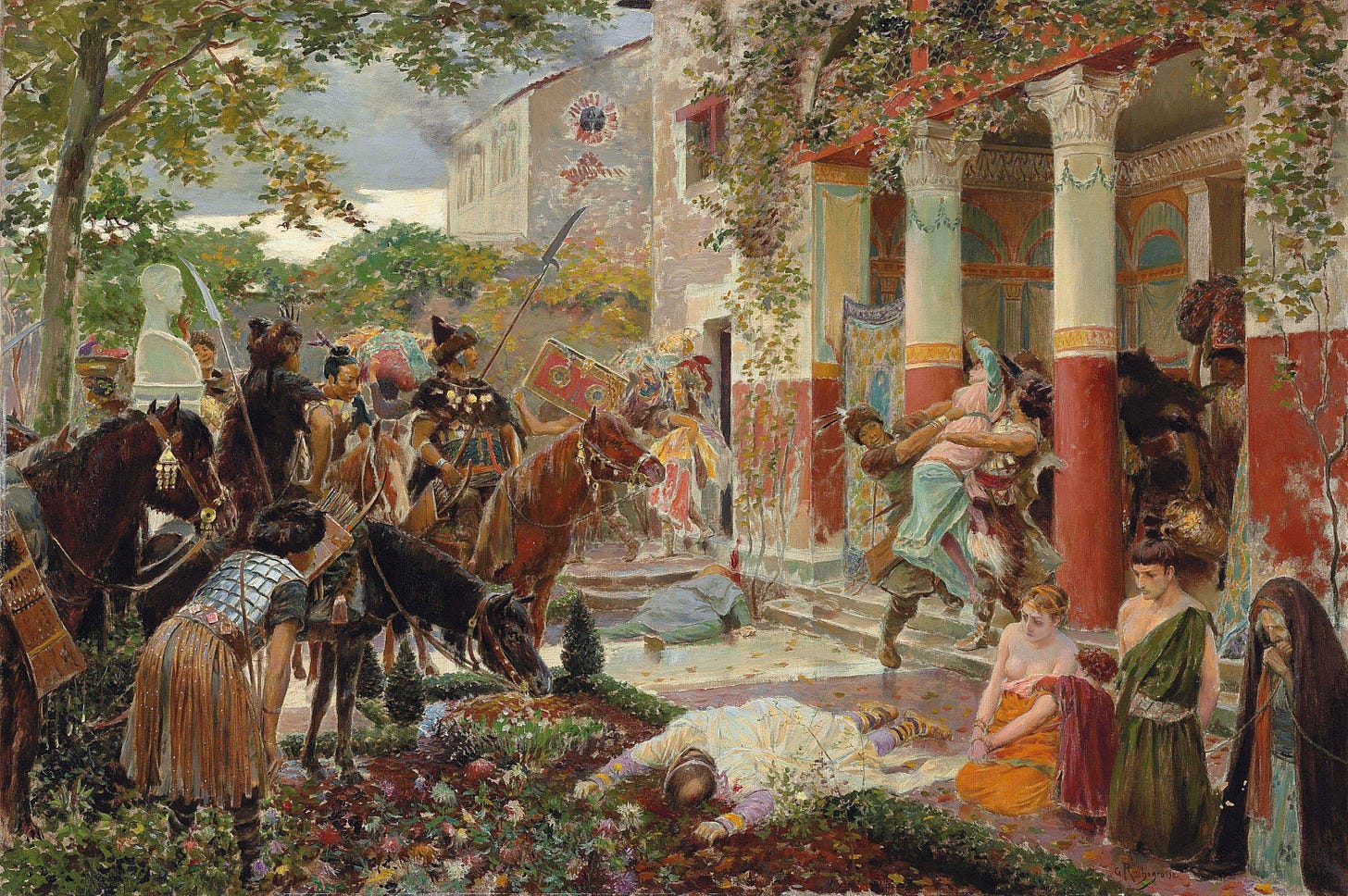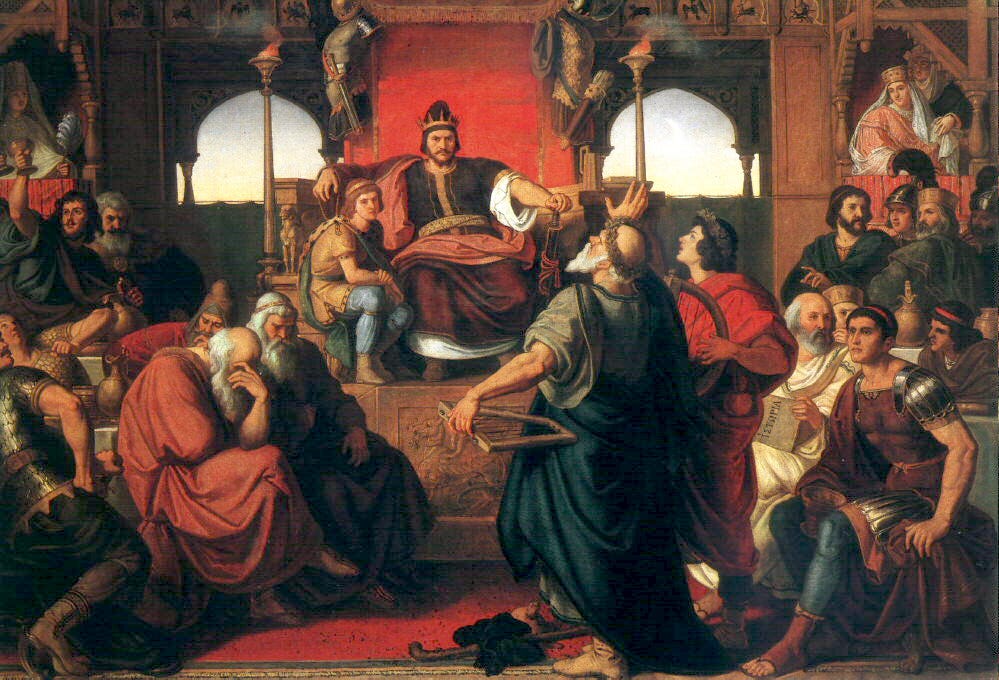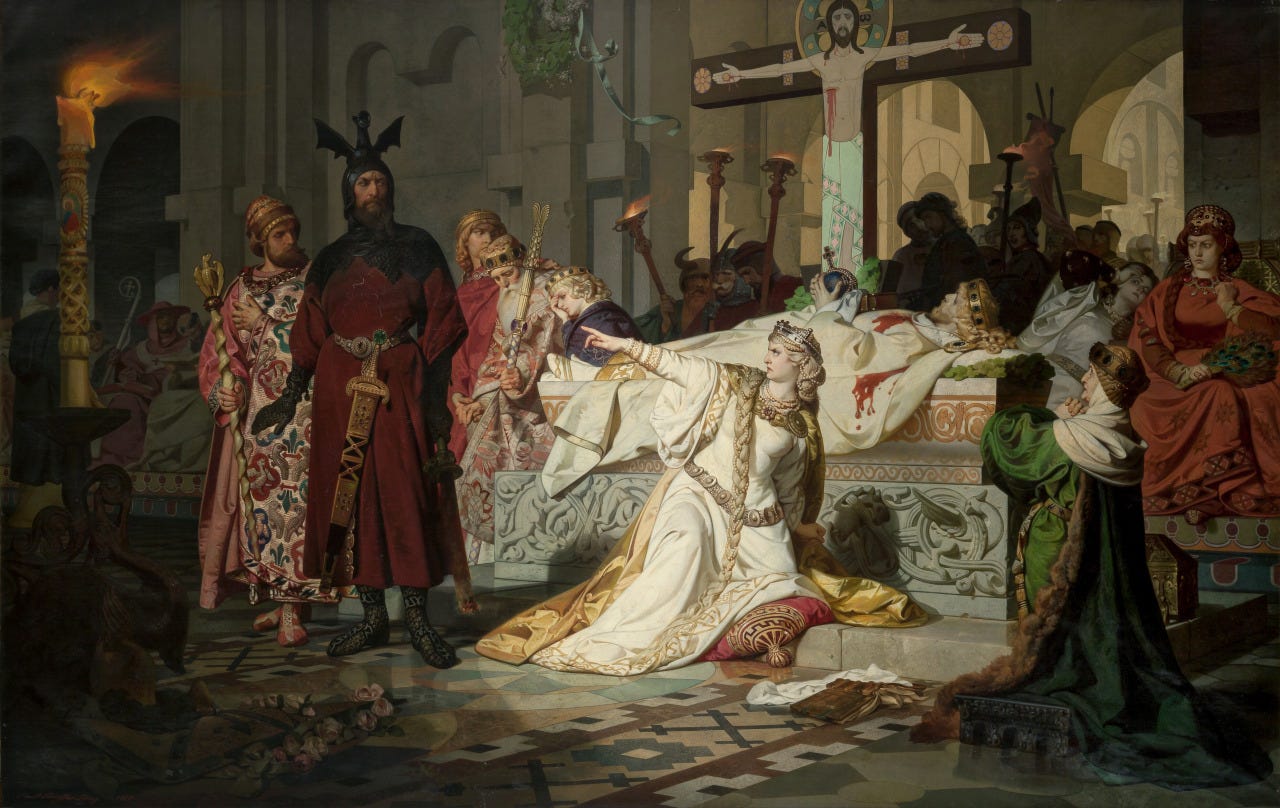The king named ‘Little Daddy’
The linguistic afterlife of Attila the Hun
June 20, AD 451, northeastern France.
Dust choked the air, thick with the iron tang of blood and the screams of dying men and horses on the Catalaunian Plains. Hooves thundered as waves of mounted warriors clashed — Hunnic archers wheeling and firing, Ostrogothic heavy cavalry smashing into Roman lines, Franks fighting Franks under opposing banners.
Then, disaster struck the Roman coalition.
King Theodoric of the Visigoths, a Roman ally, vanished into the melee while rallying his men near the centre. His men feared the worst — but their fear soon turned to anger.
Spurred by the loss of their king, the Visigoths surged forward in a furious, near-unstoppable wave. They smashed through the Hunnic lines directly opposing them, cutting down Huns and their vassals alike. The charge carried them deep into the enemy ranks, aimed directly at the heart of the Hunnic command.
Little Daddy, King of the Huns, suddenly found himself in mortal danger. The vengeful Goths were nearly upon him, spears levelled, their shouts cutting through the din. With arrows raining down and Visigoths breaking through his personal guard, Little Daddy scrambled back, retreating into the defensive circle of his wagons. He braced himself behind the wooden barricade, sword drawn, expecting the final onslaught.
But the Visigothic wave, in its fury, had passed beyond the Hunnic camp. Eventually, having spent their fury, they stopped for the night. The next day, as they retraced their steps, they found Theodoric’s body among the corpses they had left in their wake. Was he felled by a Hunnic arrow? Or trampled by his own men’s charge? No one would ever know.
His son, Thorismund, was eager for vengeance and wanted to assault the Hunnic camp right away. But the Roman general Aetius, perhaps fearing the consequences of a Visigothic victory as much as a Hunnic one, persuaded Thorismund to withdraw and return home — he would need to secure his succession to the Visigothic throne.
For the Huns, the immediate crisis had passed. Little Daddy was safe, for now. But his triumphant march through Gaul had come to an end. And the Huns’ chapter in the history books drew closer to its conclusion.
You may know Little Daddy better by his Gothic name — Attila.
But why did a king of the Huns have a Gothic name? And why was that name “Little Daddy”?
You're reading The Dead Language Society. I'm Colin Gorrie, linguist, ancient language teacher, and your guide through the history of the English language and its relatives.
Subscribe for a free issue every Wednesday, or upgrade to support my mission of bringing historical linguistics out of the ivory tower and receive two extra Saturday deep-dives per month.
This Saturday, we’ll be exploring the world of the Romans’ greatest frenemies: the Goths. I trace their surprising journey from Scandinavia to Spain (with a detour along the way to sack Rome) and walk you through a Gothic text, line by line — it may look more familiar than you might expect.
Who were the Huns?
To answer these questions, we need to answer two others first: Who was Attila? And who were the Huns?
Reading about the early life of Attila, you become accustomed to the word “likely”: Attila was likely born around AD 406, likely in Pannonia (modern-day Hungary). He was born into the heart of power within the lands of the Huns — a vast, multi-ethnic empire built on military might.
The Huns themselves were a nomadic people whose origins likely — there’s that “likely” again — trace back to the Xiongnu confederation of Central Asia that had troubled the Han Dynasty of China (202 BC–AD 220). Whatever their ultimate origins were, the Huns arrived suddenly in Europe from Asia around AD 370.
Their arrival triggered widespread upheaval, dislodging Germanic peoples like the Goths and forcing them westward or into the Roman Empire. This event marked the beginning of the Migration Period — otherwise known as the Barbarian Invasions, which accompanied the end of Roman rule in the west.
Attila was the nephew of the previous Hunnic rulers Ruga and Octar. He inherited joint power with his brother Bleda around AD 434, before securing sole rule around AD 445. What happened to Bleda? Most sources say that Attila had him murdered, although the details of just how this happened are scanty.
Under Attila’s command, the Hunnic empire became a hegemony stretching across much of Central and Eastern Europe. It was held together by Attila's authority and the need for constant acquisition of wealth — through tribute from Rome and plunder from raids — to reward his diverse followers.
Occasionally, the Huns worked for the Romans too: the Roman general Aetius, who would later fight against Attila at the Catalaunian Fields, had earlier, around AD 436 or 437, hired Hunnic mercenaries to destroy an inconvenient group of Roman “allies.” These were the Burgundians, who, under their king Gundahar, had been raiding into Roman territory despite their nominal alliance. Remember the name Gundahar, by the way, because it will become relevant soon.
Attila’s empire included numerous subjugated Germanic groups, such as the Ostrogoths, Gepids, Sciri, Rugi, and Heruli, who were compelled to provide warriors for his campaigns. His relationship with these groups was complex: the Ostrogoths fought loyally for him at the Catalaunian Plains, while the Gepid king Ardaric was considered a trusted advisor. Yet this loyalty was contingent. After Attila's death, it was that same trusted advisor, Ardaric, who led the revolt that shattered Hunnic power.
How could such a dominant military force be undone so swiftly? Part of the answer lies in the surprising sounds heard daily at Attila's court.
Why the Huns spoke Gothic
Reconstructing the precise linguistic landscape of Attila's court is difficult, as the Hunnic language itself remains poorly understood, with only a few recorded words like medos (mead) and strava (funeral feast) surviving.1
However, it’s clear that, whatever Hunnic was, it was not the sole language of power.
Given the large number of Germanic peoples within the empire, particularly Goths, the Gothic language (or closely related Germanic dialects) functioned as a common language used for communication between different groups.
Priscus, a Roman ambassador who visited Attila's camp, implies that interactions occurred in Gothic. Attila and his brother Bleda reportedly learned Gothic in their youth. And this is also likely the source of Attila’s name, which, as you may remember from earlier, is Gothic for ‘Little Daddy’ — formed from atta ‘dad’ along with the diminutive suffix -ila.2
It’s not altogether surprising that a king would be called ‘little daddy’ — Russian peasants used to call the tsar batyushka ‘little father.’
Attila’s affectionate nickname — and the fact that it was in Gothic — shows us something crucial about the Hunnic empire: loyalty was shallow, tied to Attila personally, not to a Hunnic state. Once Attila died, the ties between Huns and their subject peoples weren’t deep enough to prevent these peoples from quickly revolting and shattering the empire.
Latin also played a crucial role for the Huns — it was essential for diplomatic negotiations and treaties with the Western Roman Empire. Attila’s administration required intermediaries proficient in Latin. Key figures at court reflected this multilingual reality. Orestes, a Roman nobleman, served as Attila's secretary — his son Romulus Augustulus would ironically become the last Western Roman Emperor.
This constant interaction — commands given, negotiations conducted, stories shared, perhaps in Gothic or Latin — within a court composed of Huns, Goths, Gepids, Romans, and others, created the channels through which the memory of Attila could be transmitted. His story passed into the traditions of the Germanic peoples who served under or fought against him.
From Attila to Etzel
Attila died unexpectedly in 453 AD, not long after the Battle of the Catalaunian Fields. He had earned the nickname the Christians gave him: “The Scourge of God.” But this great warrior didn’t die a warrior’s death — although, like so much about Attila’s life, his death involves the word “likely” as well. He likely choked on blood from a nosebleed during the night of his wedding celebrations with his new bride.
Whatever the cause, his empire rapidly disintegrated in the ensuing revolts and succession struggles.
Yet Attila was a character too immense to fade away entirely. His remarkable life was followed by an even more remarkable afterlife: Attila would become a central figure in the heroic legends of the Germanic peoples he had once dominated. The transformation from historical Attila to legendary Attila likely took place through the oral traditions circulating in the multilingual environment of his empire.
In medieval German literature, most famously the epic Nibelungenlied (written around AD 1200), he appears as Etzel, the noble, powerful, and wealthy king of the Huns, ruling from Etzelburg in Hungary.
He marries the Burgundian princess Kriemhild, widow of the slain hero Siegfried. Kriemhild uses Etzel's court as her stage for revenge against her brothers Gunther and Hagen, who had orchestrated the murder of her first husband Siegfried. By the way, Gunther is the German form of Gundahar, the historical Burgundian king whose power was crushed by the Huns in AD 436–437.
Etzel, portrayed as magnanimous and somewhat unsuspecting, welcomes his brothers-in-law with lavish hospitality. He remains unaware of Kriemhild's deadly intentions until the trap is sprung. The climax is a catastrophic battle within Etzel’s hall, a bloodbath that consumes both the visiting Burgundians and many of Etzel’s own Hunnish warriors. Etzel himself is not the instigator — rather, he is caught up in the tragedy orchestrated by his vengeful wife, lamenting the loss of life on both sides.
Norse tradition, however, paints a different picture. There, Attila appears as Atli in older poems like the Atlakviða ‘Lay of Atli’ within the Poetic Edda (originating as early as the 9th century) and the later prose Vǫlsunga Saga (13th century Iceland). The Norse Atli is often depicted as a cruel, greedy, and treacherous tyrant. He marries Guðrún, Kriemhild's Norse counterpart and wife of the hero Sigurðr, the Norse equivalent to Siegfried.
Atli was consumed by avarice for the legendary Niflung (the Norse equivalent of the German Nibelung) treasure taken from Sigurðr by Guðrún’s brothers, Gunnarr and Hǫgni (the Norse equivalents of the Burgundians Gunther and Hagen). Atli invites them to his hall and, despite Guðrún’s warnings, Gunnarr and Hǫgni decide to attend.
When they arrive, Atli seizes them, violating sacred bonds of kinship and hospitality, and demands the treasure. When they refuse, he resorts to extreme cruelty: Hǫgni's heart is cut out while he is still alive, and Gunnarr is cast into a pit of vipers to die.
Atli's brutality does not go unpunished. Guðrún enacts a horrifying revenge. Although the details differ among versions, they go something like this: She kills the two young sons she had by Atli, cooks their hearts, and serves them to Atli at a feast. After revealing the truth, she kills Atli himself by stabbing him in his bed as he sleeps off the feast, and then sets fire to his hall, consuming everything in flames. This Atli aligns more closely with the image of a feared and ruthless conqueror.
Despite the stark differences between the noble Etzel and the cruel Atli — reflecting separate lines of legendary development over centuries — both figures retain traces of the historical Attila. Both command immense power and wealth. Both are associated with the Huns and a kingdom roughly corresponding to historical Hungary. And most significantly, both are linked, whether as onlooker or perpetrator, to the legendary destruction of the Burgundian kings — echoing what actually happened when the Huns crushed the Burgundians in AD 436–437.
And that’s how Attila — the Hunnic warlord known to history as “Little Daddy” — achieved a strange kind of immortality.
Long after his empire crumbled and the precise details of his historical reign faded, his name echoed in Germanic oral tradition. Filtered through centuries of storytelling, Attila was remade: here into a noble host, there into a monstrous tyrant. His enduring presence in legend, however contradictory, shows the force of his impact on the history of Europe and the power of tales to transform in the telling.
Even these few recorded words look Indo-European — in other words, related to English, Latin, Greek, and most other languages of Europe. Medos ‘mead,’ for example, looks a lot like English mead! So it’s not clear whether these words were in fact drawn from the original language of the Huns, or from other languages spoken in the Hunnic court.
There are alternative theories for Attila’s name outside of Germanic, but they don’t match as exactly as the Gothic ‘Little Daddy’ theory does.






The women of these people were just as violent as the men, apparently! Quite a relief after all the princesses in our mythology.
Great post — just a quick note: in the Norse version, Guðrún is Sigurðr’s wife, not his sister.
Really enjoyed the read!